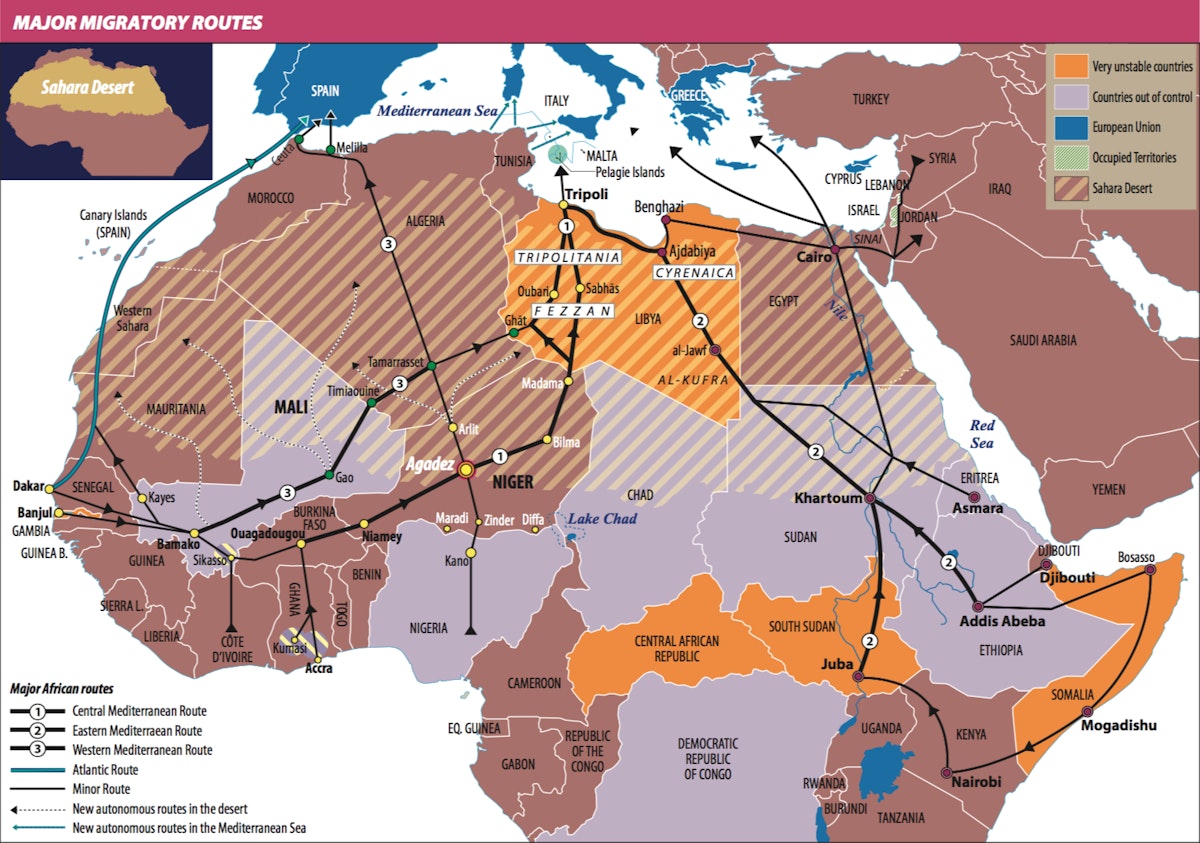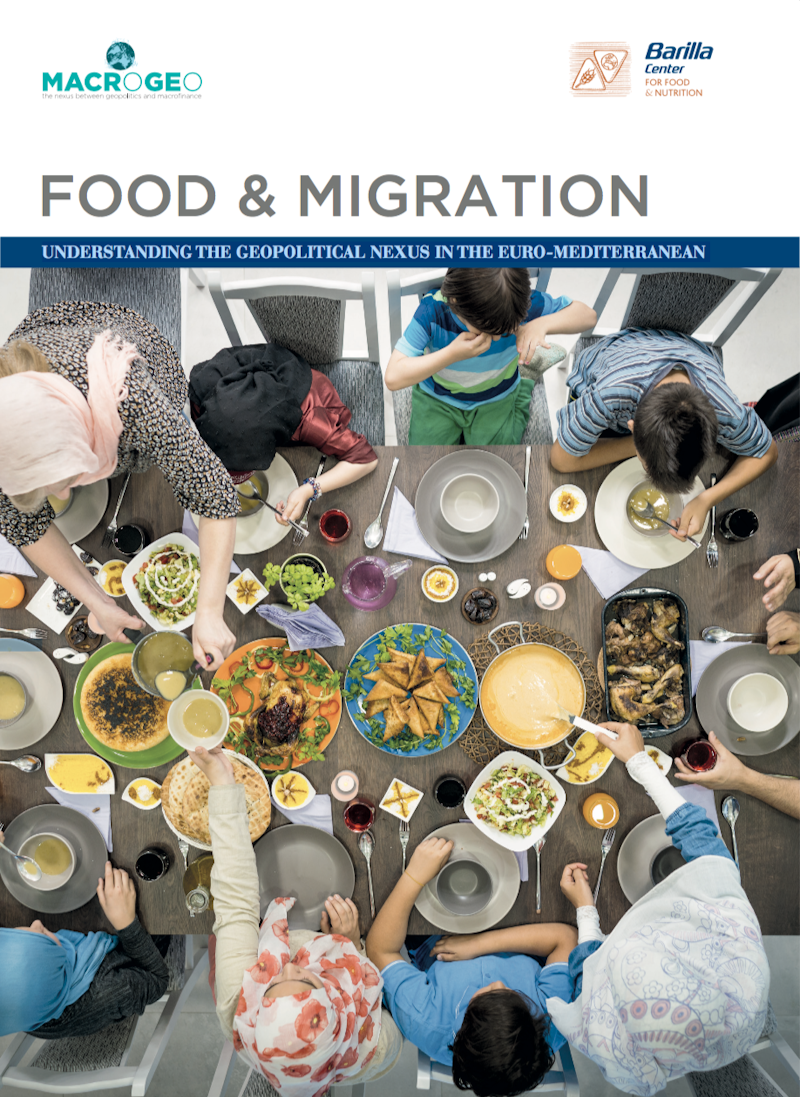Routes of Trans-Mediterranean Migration
by Luca Raineri
The main migratory routes across the Mediterranean and towards Europe are the Atlantic route, the Central Mediterranean Route, The Eastern Mediterranean Route and the Balkan Route. The infrastructure of migration often uses, as in Agadez, previous routes built for smuggling foodstuffs and labourers, and it fosters a thriving criminal economy. Migratory flows tend to react quite quickly and adapt to political and economic shifts occurring in the countries of origin, transit and destination, therefore they need to be constantly analysed.

Throughout the years, several different routes of migratory flows across the Mediterranean and towards Europe have been carved out. Their popularity, and the magnitude of the flows in transit, have changed depending on shifting social and political circumstances. Their scope and scale, however, increased significantly in the last couple of decades, and most notably since 2011 as a result of the collapse of authoritarian regimes in the MENA (Middle-East and North Africa) region during the Arab Spring. Long-lasting humanitarian crises, including in the Sahel, the Horn of Africa, the Middle-East and Central Asia, have combined with the economic downturn of raw-materials export-based economies across the world, and pushed an increasing number of individuals to look for better life opportunities abroad.
This section sketches the changing dynamics of the most important migratory routes leading to Europe across the Mediterranean, and the following section will present case-studies on links between agricultural production and migration networks.
The Atlantic Route
In the early 2000s, the prominent role of Spain as one of the main entry points of migrants – most notably from West Africa – to Europe contributed to consolidating the so-called West Mediterranean and the Atlantic routes. Migrants accessed Spain through the enclaves of Ceuta and Melilla, or most frequently by boat from Morocco. Following the entry into force of more stringent regulations against irregular migration from and across Morocco in 2003, a new route was progressively developed, leading to Spain from Senegal and Mauritania via the Canary Islands. The popularity of the Atlantic route peaked in 2006, when approximately 32,000 migrants landed in Spain’s Canary Islands. This was also due to the crisis of the local fishing industry, one of the most labour-intensive in Senegal. Opaque fisheries exploitation deals passed between Senegal and foreign countries contributed to depleting natural stocks and the ruin of local fishermen. The latter thus had little choice but to turn into either migrants or smugglers. Since 2007, however, the entry into force of bilateral agreements between Spain, on the one hand, and Senegal and Mauritania, on the other, contributed to considerably reducing these flows. In 2016, 10,631 attempts of illegal border crossing were detected between Spain and Morocco, while entries via the Atlantic route were just 671. However, the popularity of this route is soaring again in 2017.1
The Central Mediterranean Route
The Central Mediterranean Route (CMR) connects the south of Italy to North Africa, and Libya most notably. However, its branches draw deeply into sub-Saharan Africa. The flow of African migrants reaching Italy had always been modest, but it started to increase in the early 2000s, in correspondence with the growing restrictions along the Western Mediterranean route through Morocco, and then boomed in 2008. That year, an unprecedented 31,000 migrants arrived in Italy, out of which 23,000 were from Africa, including approximately 6,000 Nigerians, 5,000 Somalis, and 3,000 Eritreans. The following year, the entry into force of the “Treaty of Friendship and Cooperation” between Italy and Libya contributed to reducing this flow by more than half, but the collapse of the Ghaddafi regime in 2011 and the failure of the state-building process in 2014 prompted another upsurge, whose scale was again without precedent. Arrivals by sea in Italy soared substantially in the subsequent years, from about 43,000 in 2013, to 170,000 in 2014, 153,000 in 2015, and 181,000 in 2016.2 Throughout the same period, a remarkable number of approximately 93,000 Eritreans, 66,000 Nigerians and 27,000 Gambians reached Italy, thereby suggesting that the CMR had branched out towards both West Africa and the Horn. Flows tend to converge in the Nigerien city of Agadez, where migrants in transit have increased from estimated at 40-60,000 in the early 2010s, to more than 250,000 in 2016.
The quantity and diversity of the migrants along the CMR makes it almost impossible to determine the average profile of those setting off for Libya. Young males largely prevail - thus, generally it is less the starving and poorest, but rather the dissatisfied low-middle class (De Haas 2010). Push factors are also varied: in places like Eritrea and Gambia, the presence of authoritarian regimes and systematic human rights abuses has certainly played a major role. In Somalia, migration is linked to state collapse and widespread insecurity. In Nigeria, migratory flows towards Europe do not originate from the north-eastern areas affected by Boko Haram, but from the relatively richer and safer Edo State, thereby suggesting the impact of the recent economic crisis. Yet limited migratory flows originate from other countries in the region facing similar challenges, and show the relevance of cultural factors and path-dependencies.
The boom of migration towards Libya and Italy has triggered the development of a veritable “business of migration”. In spite of the over-simplified image often suggested by media and policy discourses, in fact, human smuggling is a composite enterprise nested in local political economies, not necessarily violent, and enjoys a fundamental impunity which relies on well-oiled corruptive schemes. From West Africa, prospective migrants reach Agadez by public transport. In many cases, bus companies belong to businessmen sponsoring the local political leaders, who are happy to turn a blind-eye to the patterns of irregular mobility in exchange for a share of the profits. From East Africa, on the contrary, better structured cartels organise the smuggling of migrants from their countries of origin to the Mediterranean shores, generally across south-east Libya and most notably through the city of Kufra. Across the Sahel security forces are often seen to cooperate with the smugglers, and exert a systematic protection racket by extorting an informal “fee” to ensure safe passage. The flow of migrants has made transit cities, like Agadez, also destinations for migrants, who are attracted by the (informal) job opportunities set in motion by the thriving industry of migration. Through local eyes, then, the latter is seen more as a source of development and stability than as a destabilising criminal threat. From Agadez, migrants cross into Libya thanks to the infrastructure developed in the 20th century for the smuggling of foodstuffs from the north, and of agricultural labourers from the south.
One finds a different situation in Libya, where enforcement is subcontracted to different militias, many of which have vested interests in the business of migration while enjoying complete impunity. Tebu ethnic networks, which were marginalised under Ghaddafi, have managed to control the most significant routes in south Libya, and cooperate across political divides with smuggling networks and militias intersecting in the launching ports of north-west Libya. The profits of smuggling thus contribute to perpetuating centrifugal forces which hinder the process of state-building. This context represents a breeding ground for the emergence of widespread patterns of abuses, including labour and sexual exploitation, kidnapping-for-ransom, and sales of organs. However, in spite of alarmistic media reports, there is no real evidence of the involvement of jihadist insurgent groups, such as Al-Qaeda and the Islamic State, in the organization of human smuggling to and across Libya.
Across migratory routes, local governments fail to enforce harsh repressive measures against human smuggling also because the remittances of migrants abroad often contribute significantly to local livelihoods and development. In Nigeria, for instance, remittances of the diaspora are estimated to exceed USD 20 billion per year, and in Senegal they represent the first source of foreign currency in the country (Devillard et al. 2015).
The Eastern Mediterranean Route and the Balkan Route
Networks of all sorts devoted to the smuggling of both legal and illegal commodities have existed for decades cutting across the short maritime border that separates Greek Islands from the Turkish mainland. Following the deterioration of the security situation in Syria, the skyrocketing demand for transit provided a unique opportunity to dramatically boost the business of smuggling. The flow of Syrians, however, did not prompt the creation of a brand new route, but added to the migrant flows from Iraq, Afghanistan, Iran and Pakistan which have been constant here throughout the last decade, featuring approximately a total amount of 40-50,000 crossings per year between 2008 and 2014.3
In 2015, these figures rose dramatically, when the increasing restrictions along other migratory corridors, via Egypt and Libya most notably, forced Syrian migrants and asylum-seekers to look for alternative routes. Facing limited restrictions in Turkey, and a relatively easy journey across the Aegean, the Eastern Mediterranean route featured prominently among them. Hundreds of thousands of Syrian migrants then headed to Turkey’s eastern ports of Bodrum, Izmir, Cesme, Dikili, and Ayvalik, from where they managed to be shipped for a relatively cheap price and reduced risk to the outer Greek Islands such as Kos, Samos, Chios and Lesbos. An unprecedented amount exceeding 857,000 undocumented migrants was detected along this route in 2015, 56% of which were Syrians, 24% Afghans, and 10% Iraqis. In Greece, those fleeing war-torn countries were indiscriminately granted transit permits, which gave them the opportunity to continue their journey towards their intended destinations and file their demands for international protection in central and northern Europe. Migrants could then move relatively unhindered via public transport to Greece’s mainland, and from there to the heart of Europe. The largest share of this flow, i.e. more than 550,000 migrants, thus continued overland across the Balkans, including through Bulgaria, Macedonia (Former Yugoslav Republic of), and Serbia, before splitting into two branches accessing the EU respectively in Hungary and in Croatia. Fearing the effects on local public opinion, south-eastern European countries’ governments did their best to smooth this flow and make sure that migrants could reach their intended destinations, such as Germany or Sweden, as expeditiously as possible.
Since 2016, however, the political, social and economic challenges stirred by the management of this flow have prompted the reaction of European authorities. Restrictive measures at national, European and international level were adopted to constrain the flow across this route, including the EU-Turkey deal in March 2016, and the implementation of limited entry-quota in Hungary in July 2016. While the legal status of these provisions remains controversial, they succeeded in considerably reducing migration figures across the Eastern Mediterranean and the Balkan routes. As compared to 2015, flows shrank by about 80% in Greece, where approximately 177,000 undocumented migrants arrived in 2016, 87% of which came from three countries: Syria (about 80,000), Afghanistan (about 40,000) and Iraq (about 25,000). Figures are even more striking in the subsequent legs of the journey: flows have reportedly reduced by more than 95% in Hungary and Croatia, leading to the substantial draining of the Balkan route.
Conclusions: trends and expectations
Migratory flows tend to react quite quickly and adapt to political and economic shifts occurring in the countries of origin, transit and destination. The high number of variables at play, then, makes it hard to come out with reliable forecasts, and obliges one to draw on existing trends and likely scenarios.
In the long-term, only a strong and determined government in Tripoli might be able to significantly curb migration in Libya. Yet stability is not in sight yet. A low-intensity conflict with sudden eruptions of large-scale violence is likely to continue in the foreseeable future. What can change are the countries of origin and transit from where migrants reach Libya.
In 2017, the increasing limitations prompted by EU action in Agadez obliged smugglers to circumvent the Saharan city. Smaller and more dangerous paths across the desert were developed, transiting for instance through Arlit in Niger and Gao in Mali. In the meantime, the consolidation of smuggling networks started to involve other countries in Africa and elsewhere, which were previously left out of the main migratory routes. For instance, growing numbers of Guineans and Bengalese are part of this trend.
Since mid-summer 2017, we are experiencing a significant change on CMR, as volumes of migration shrank abruptly. While this was widely seen as the result of the co-option of Libyan militias into anti-smuggling efforts prompted by the Italian and other EU governments, this solution proved short-lived and unsustainable, as armed clashes soon erupted in key transit nodes. Although the overall number of arrivals in southern Italy has declined, deaths at sea remain just as high and new trans-Mediterranean routes are being carved out, including from Tunisia, Algeria and Egypt. The current management of migratory flows amounts to a veritable time-bomb. Figures largely exceed the absorption capacity of neighbouring and transit countries. While the legitimacy of the current legal framework externalising border control remains debatable, the humanitarian emergencies and political controversies resulting from this situation risk to be unsustainable in the long run, and to further exacerbate existing tensions and security cleavages.


